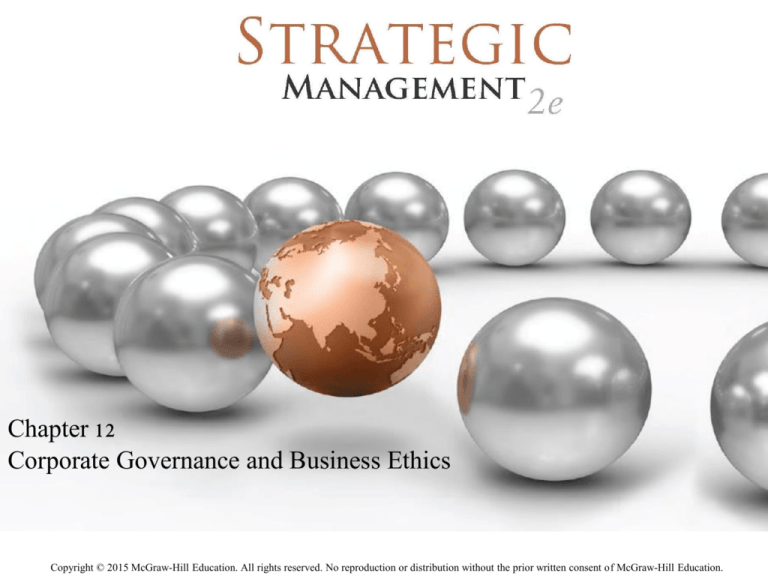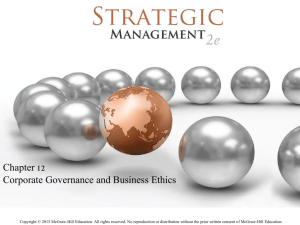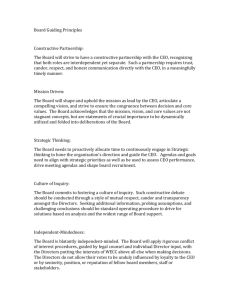
Chapter 12
Corporate Governance and Business Ethics
Copyright © 2015 McGraw-Hill Education. All rights reserved. No reproduction or distribution without the prior written consent of McGraw-Hill Education.
12-2
Exhibit 12.1 The HP Way
12-3
Exhibit 12.2 HP Stock Performance
Under CEOs Hurd, Apotheker, and Whitman
12-4
12.1 The Shared Value Framework
Guidance to managers on competitive advantage
• Economic imperative
• Corporate social responsibility (introduced in Ch. 1)
Creates a larger pie
• Benefits shareholders and other stakeholders
12-5
Public Stock Companies and
Shareholder Capitalism
Public stock companies are vital in free market
economies.
Four attractive characteristics of public firms:
1)
2)
3)
4)
Limited liability for investors
Transferability of investor interest
Legal personality
Separation of ownership and control
12-6
Exhibit 12.3 The Public Stock
Company Hierarchy of Authority
12-7
MILTON FRIEDMAN VS. MICHAEL PORTER
Traditional View: (Friedman)
• Shareholder capitalism: shareholders – the providers of the
necessary risk capital and the legal owners of public
companies – have the most legitimate claim on profits.
Shared Value View: (Porter)
• Corporate social responsibility (CSR): obligations extend
beyond the economic responsibility and include legal,
ethical, and philanthropic societal expectations
12-8
Exhibit 12.4 Global Survey of Attitudes
toward Business Responsibility
12-9
Shared Value Framework
Reestablish the relationship between superior firm
performance and societal progress
• Enable firms to gain and sustain a competitive advantage
• Reshape capitalism and its relationship to society
Externalities
• Pollution, wasted energy, and costly accidents increase
• Internal costs in lost reputation if not directly on the bottom line
Porter suggests that the two can be reconciled to create a
larger pie.
Example: GE ecoimagination initiative
• Generated $25B in sales in 2012
12-10
CONNECTING ECONOMIC AND SOCIETAL NEEDS
Michael Porter: Managers focus on three things here.
1. Expand the customer base to bring in nonconsumers .
•
Including those at the bottom of the pyramid
2. Expand traditional internal firm value chains to include
more nontraditional partners.
•
For example, nongovernmental organizations (NGOs)
3. Focus on creating new regional clusters.
•
Chilecon Valley and Bangalore
12-11
12.2 Corporate Governance
AGENCY THEORY
• A theory that views the firm as a nexus of legal contracts
BOARD OF DIRECTORS
• The centerpiece of corporate governance, composed of inside
and outside directors who are elected by the shareholders
OTHER GOVERANCE MECHANISMS
• Executive compensation
• The market for corporate control
• Financial statement auditors, government regulators, and
industry analysis
12-12
Corporate Governance (cont’d)
Corporate governance
• Mechanisms to direct and control a firm
• Ensure the pursuit of strategic goal
• Address the principal−agent problem (introduced in Ch. 8)
When corporate governance fails
• Accounting scandal
• Global financial crisis
Information asymmetry
• Insider information: Galleon Group
• On-the-job consumption: Tyco & Merrill Lynch
12-13
Exhibit 12.5 Principal-Agent Problem
12-14
Corporate Governance (cont’d)
Agency Theory
• Views a firm as a nexus of legal contracts
Relationships among shareholders, managers, and hierarchies.
Front-line employees have an advantage over management.
Firms need to design work tasks.
Adverse Selection
• Misrepresentation of a job
Beyond his/her ability to do things
Moral Hazard
• Difficulty to ascertain whether the agent gives his/her best
12-15
The Board of Directors
Centerpiece of corporate governance
• ChapterCase − problems can drain shareholder value
Different shareholder goals
• Institutional investors
• Individual short-term investors
Inside directors
• Generally part of the company’s senior management team
Outside directors
• Not employees of the firm
Senior executives from other firms or full-time professionals
12-16
FUNCTIONS OF THE BOARD OF DIRECTORS
Selecting, evaluating, and compensating the CEO
Overseeing CEO succession plan
• Recently problematic at both HP & Apple
Providing guidance on executives & their compensation
Reviewing, monitoring, & approving strategic initiatives
Conducting a risk assessment and mitigation
Ensuring a firm’s audited financial statements
Ensuring a firm’s compliance with laws and regulations
12-17
Strategy Highlight 12.1
GE’s Board of Directors
16/17 members are independent outside directors
Comprised of business, academia, & government
Duality – Jeffrey Immelt, the one inside director, is
both the CEO and chairperson of the board, a declining
practice due to the conflict of interest
GE’s board has 5 committees.
Boardroom diversity (28% for GE) in backgrounds and
expertise is considered an asset: More diverse boards
are less likely to fall victim to groupthink.
12-18
Other Governance Mechanisms
Executive Compensation
The Market for Corporate Control
Financial statement auditors, government
regulators, and industry analysis
12-19
EXECUTIVE COMPENSATION
Salary, bonus, and stock options (long-term
incentives)
CEO pay - two issues:
1. CEO pay compared to average employee pay
•
•
U.S. ratio 2012: 300 to 1, 1980: 40 to 1
Average CEO pay in Fortune 500 firm: $11 million
2. Firm performance and CEO pay
•
•
McKesson high salary but also high performance
Home Depot, HP….NOT
12-20
Other Governance Mechanisms
(cont’d)
The market for corporate control
• External governance mechanism
• Hostile takeover
• Corporate raiders and hedge funds
2013 − Dell’s LBO was a target of Carl Icahn.
Auditors, government regulators, and
industry analysts
• SEC- GAAP as reported publicly via EDGAR
• The Wall Street Journal, Bloomberg BusinessWeek,
Forbes…
• GovernanceMetrics International (GMI Ratings)
12-21
12.3 Strategy and Business Ethics
Business ethics
• Agreed-upon explicit code of conduct in business
Legal conduct vs. Ethical conduct
• Legal (min acceptable standard), but may not be ethical
Mortgage brokers selling “option ARMs”
• Ethical, but may not be legal
Pharmaceutical firms discussing pricing to increase affordability
When facing ethical dilemma:
• Do the actions fall into acceptable norms of professional
behavior?
• Does it feel comfortable explaining and defending the
decision in public?
12-22
Strategy Highlight 12.2
Did Goldman Sachs and the “Fabulous Fab” Commit
Securities Fraud?
The SEC alleged that Goldman violated its fiduciary
responsibility and defrauded its clients.
Collateralized Debt Obligation (CDO) such as Abacus
• Roll-up of risky investments into a AAA-rated CDO
Rating agencies falsely viewed these as safe investments!
Goldman Sachs settled by paying a $550 million
• Did not admit any wrongdoing
• Mr. Tourre convicted of securities fraud in Aug. 2013
12-23
ORGANIZATIONAL CONTEXT
Is unethical behavior just a few “bad apples”?
Research – some organizations have unethical climate
• Ethical decision making depends on the organization
Enron−creating an inflated share price at any cost
Employees observed and followed the behavior set by leaders.
Ethical leadership is critical.
• CEOs at large public firms face increasing scrutiny.
Mark Hurd fired at HP without proof of illegal behavior
• Formal and informal cultures
Must be aligned with executive behavior
12-24
Exhibit 12.6 The MBA Oath
12-25
12.4 Implications for the Strategist
Effective corporate governance and business ethics
• Critical to gaining and sustaining competitive advantage
Strategic leaders need to take actions with integrity.
IBM emphasizes its values across the globe.
• Example of an employee falling ill at a training session
• An expectation among IBMers−a “lived” value
Glaring ethical lapses in the last 10 years call for:
• Ethical values and code of conduct
• Professionalization of management
12-26
ChapterCase 12
©ChinaFotoPress via Getty Images
Consider This…
• HP featured in the bestseller Built to Last (1994)
Much has changed since Mr. Hewlett’s death in 2001.
• HP board’s decisions destroyed $82 billion in
shareholder value.
Exhibited groupthink in rallying around Mr. Apotheker as CEO
Full board never met him before hiring him.
Flawed due diligence process in the Autonomy acquisition
Lack of an open search to appoint Meg Whitman as CEO
12-27









